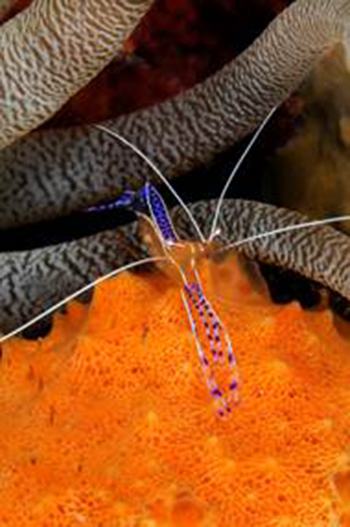Pederson's Cleaner Shrimp
Periclimenes pedersoni

Taxonomy:
Kingdom: Animalia
Phylum: Arthropoda
Class: Crustacea
Subclass: Malacostraca
Order: Decapoda
Suborder: Natantia
Genus: Periclimene
Species: pedersoni
Distribution and Habitat:
Pederson’s cleaner shrimp live associated with a specific variety of sea anemones in warm tropic waters. Two common sea anemones with which it is associated are Bartholomea annulata and Condylactis gigantean (Ochoa). The cleaner shrimp is largely distributed; they inhabit anemones from the Caribbean to the waters between southern Florida and Colombia.
Description:
The Pederson’s cleaner shrimp is a small translucent shrimp with blue, light blue, and lavender spots and strips located on the abdomen, tail, and legs. They have long white antennae and grow to a size of about 3cm. The cleaner shrimp’s translucent body with its few markings allows it to hide and disappear among the sea anemone.
Behavior & Food Habits:
Pederson’s cleaner shrimps have a symbiotic relationship with its sea anemone. They are dependent on the sea anemone and are rarely found far from them because although the shrimps have a shell, the anemone provides protection from predators. In return, the shrimp cleans the anemone removing organism caught in the anemone’s mucus. Therefore, they feed on the tiny organisms and detritus that get caught in the anemones mucus. The cleaner shrimp also wave their antennae to attract fish to their “cleaning stations”. The cleaner shrimp has a mutualistic relationship with the fish. They remove parasites from stationary fish that are passing by. They also clean inside the mouth and gill coverings of the fish.
Although the Pederson’s cleaner shrimp have an armored exoskeleton, this does not protect them from the sea anemones sting produced by the nematocysts. The cleaning shrimp has to adapt themselves to their host. This is done by slowly making contact with the tentacles of the anemone. After this process is done repeatedly, the shrimp develops immunity and can move about the anemone unaffected. Similarly, the anemone also no longer notices the presence of the cleaner shrimp.
Reproduction:
The male cleaner shrimp inserts his sperm into the female at her genital opening. The female then carries the fertilized eggs at her pleopod. She then releases the young into the water column, which produces a pelagic larval form. After the young planktonic shrimp develops it immediately finds its host anemone. The host anemone is located by the shrimp by smell, sight, and some even use chemical cues to distinguish between different anemone species (Michael).
Economic/Ecological Services:
The Pedersen cleaner shrimp removes the parasites from the body, mouth, and gill of fishes. This keeps the fishes clean and healthy, decreasing the chance of parasitic infection and disease. This is important for human trade and consumption of fish.
Recent Research:
The recent research on the Pederson’s cleaner shrimp varied from studies on differences in cleaning tasks preformed by the cleaner shrimp versus goby (Kaplan, Lappas, Luboon , and Sullivan) to studies on the removal of parasites between the Pederson’s cleaner shrimp and other “cleaners” (McCammon, Nemeth, and Sikkel). The research on the differences in cleaning area and size preformed by the cleaner shrimp and goby concluded that the shrimp cleaned the gills and eyes, while the goby cleaned the sides of the client fish. Also, there was no notable difference in the thoroughness of the cleaned area or the duration of the cleaning process between the two. The second study on the removal of parasites between various cleaners concluded that the Pederson’s cleaner shrimp had the greatest effect on the amount of parasites removed and largest area cleaned from Caribbean fish versus other “cleaner” shrimp.
References:
Brown,Barry. Coral Reef Photos. 2011. Photograph. http://www.coralreefphotos.com/pederson-cleaner-shrimp-periclimenes-pedersoni/bar-60/, Curacao, Netherlands Antilles. Web. 28 May 2013.< http://www.coralreefphotos.com/pederson-cleaner-shrimp-periclimenes-pedersoni/bar-60/>.
Chace. "Perderson Cleaning Shrimp." Interactive Guide to Caribbean Diving. Marine Species Identification Portal.Web. 28 May 2013. <http://species-identification.org/species.php?species_group=caribbean_diving_guide&id=115>.
Kaplan, Samanth R., Brain M. Lappas, Thomas J. Luboon , and Jenna M. Sullivan. "Sharknose Goby and Pederson Shrimp Provide Distinct Cleaning Services to Client Fish." Dartmouth.edu. (2008): 1-4. Print.< http://www.dartmouth.edu/~biofsp/pdf08/177_SIFP2_ACCEPTED_cleaners.pdf>. 3.
McCammon, A, D Nemeth, and P.C. Sikkel. "Effect of three Caribbean cleaner shrimps on ectoparaitic monogeneans in a semi-natural environment." Coral Reefs. 29. (2010): 419-426. Print.
Michael, Scott . "Anemone Shrimp." FishChannel.com. Coast Tropicals . Web. 28 May 2013.<http://www.fishchannel.com/saltwater-aquariums/species-info/invertebrates/anemone-shrimp.asp&xgt;.
Ochoa, Edgardo. "Periclimenes pedersoni." Bocas del Toro: Species Database. Smithsonian Tropical Research Institute. Web. 28 May 2013.< http://biogeodb.stri.si.edu/bocas_database/search/species/2738>.
Unknown, . "Pederson Cleaner Shrimp." iNaturalist.org. Catalogue of Life. Web. 28 May 2013.< http://www.inaturalist.org/taxa/128124-Periclimenes-pedersoni>.